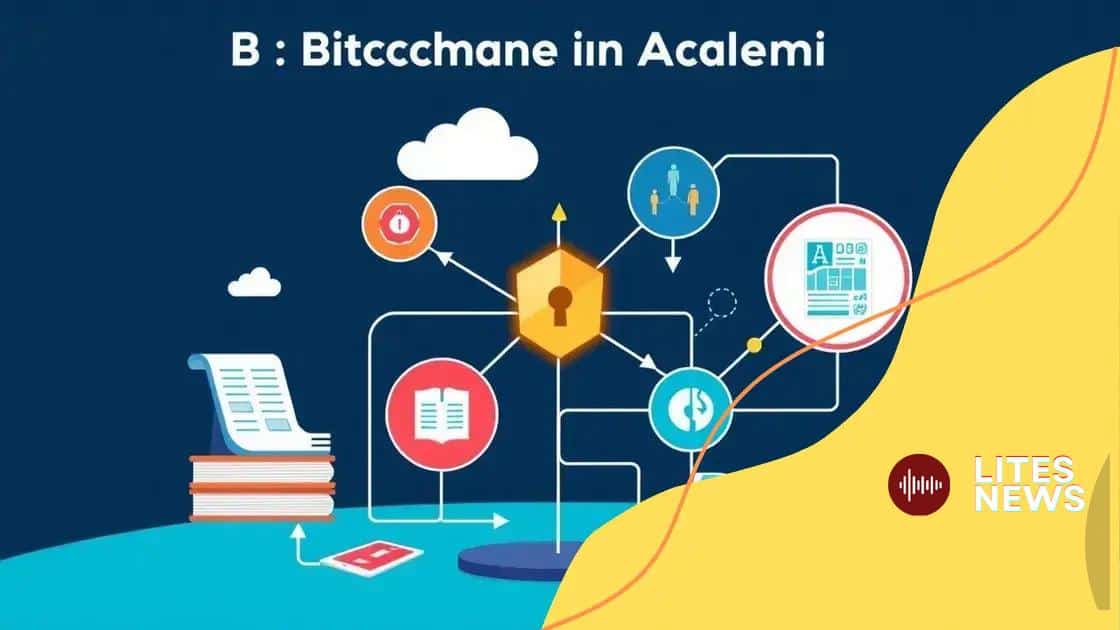Blockchain for secure academic records: A game changer

Blockchain for secure academic records revolutionizes education by providing tamper-proof credentials, enhancing verification processes, and empowering students with control over their data.
Blockchain for secure academic records is not just a buzzword; it’s reshaping the way educational institutions manage credentials. Have you ever wondered how it can foster trust and streamline processes? Let’s dive into this innovative approach.
Understanding blockchain technology
Understanding blockchain technology is crucial to grasp its applications in various fields, especially in education. At its core, blockchain is a decentralized digital ledger that records transactions across multiple computers. This technology offers enhanced security, transparency, and trust.
Key Features of Blockchain
Blockchain operates through a series of interconnected blocks that contain data. Each block is linked to the previous one, creating a secure chain. Some important features include:
- Decentralization: Unlike traditional databases controlled by a single entity, blockchain data is distributed across a network.
- Immutability: Once a block is added, it cannot be altered, ensuring the integrity of the data.
- Transparency: All transactions on a blockchain are visible to participants, promoting accountability.
This technology operates on a consensus mechanism that ensures all participants agree on the validity of transactions before they are added to the blockchain. By leveraging this feature, educational institutions can maintain accurate and tamper-proof records of academic achievements.
How Blockchain Works in Education
When applying blockchain to academic records, the first step involves creating digital credentials. Each credential is stored as a unique block on the chain, making it easily verifiable. For example, if a student graduates, their diploma is recorded on the blockchain. Anyone can check its authenticity by accessing the blockchain.
Furthermore, this process saves time and resources. Institutions no longer need to manually verify credentials, as the blockchain facilitates quick access to verified information. Not only does this enhance efficiency, but it also builds trust among employers and educational bodies.
As blockchain technology continues to evolve, educational institutions must embrace its potential. By doing so, they can foster an environment of transparency and trust, ultimately leading to enhanced value in academic credentials.
How blockchain ensures data integrity
How blockchain ensures data integrity is a key factor in its growing popularity across various fields. By design, blockchain technology maintains a secure and accurate record of all transactions. This creates a resilient system where data cannot be easily altered or deleted.
Mechanisms Promoting Data Integrity
Blockchain achieves data integrity through several mechanisms. Each piece of information is grouped into blocks and secured with cryptographic hashes. This process makes it extremely difficult for unauthorized users to change any part of the data. Some essential mechanisms include:
- Cryptographic Hashing: Each block in the chain contains a unique hash that represents its contents. Any change to the data will alter the hash, signaling tampering.
- Consensus Protocols: Blockchains utilize consensus among network participants to validate new transactions. This means that no single entity can alter the records alone.
- Timestamping: Every transaction is time-stamped, providing a chronological order that helps track the integrity of the data flow.
These elements work together to create a system where data integrity is not just a feature but a fundamental characteristic. Blockchain allows users to trust the information stored within because the architecture supports transparency and accountability.
When educational institutions use blockchain, they enhance their ability to provide verifiable and authentic credentials. A degree or certificate recorded on the blockchain can be easily verified by employers, ensuring that the information is accurate and untampered.
Over time, as blockchain technology becomes more integrated into various sectors, its role in ensuring data integrity will become increasingly vital. Organizations focusing on data management must consider adopting blockchain solutions to enhance security and build trust with their stakeholders.
Benefits of using blockchain in academia

Benefits of using blockchain in academia are numerous and impactful. As educational institutions explore new technologies, blockchain emerges as a powerful tool that enhances many aspects of academic operations. This innovative technology supports secure and efficient management of educational credentials.
Enhanced Security
One major benefit is the enhanced security it provides. Traditional methods of record-keeping can be vulnerable to fraud and tampering. By storing records on a blockchain, institutions create a secure, tamper-proof environment. This significantly reduces the risk of data breaches and unauthorized access, while simultaneously promoting trust.
- Immutable Records: Once a record is added to the blockchain, it cannot be changed or deleted. This ensures that all academic credentials remain authentic.
- Decentralized Verification: Employers and other institutions can easily verify credentials without needing to contact the school directly, saving time and resources.
Blockchain’s decentralized nature also empowers students. They gain the ability to manage their own records, granting them greater control over their academic achievements.
Streamlined Processes
In addition to security, blockchain simplifies many processes in academia. It allows for efficient sharing of information across institutions. Imagine students transitioning between schools or seeking employment; they can provide verified records instantly, streamlining admissions or hiring processes.
Further, the technology fosters transparency. With blockchain, students can track their academic journey and access their information anytime. This leads to improved engagement and a more informed educational experience.
As adoption of blockchain technology continues, it will reshape how academic records are managed and shared. By embracing these benefits, educational institutions can enhance their ability to serve students and foster a trustworthy environment.
Real-world applications of blockchain in education
Real-world applications of blockchain in education showcase the practical benefits and innovations stemming from this technology. As educational institutions adopt blockchain, they implement solutions that enhance efficiency and security in record management.
Credential Verification
One significant application is in credential verification. Traditional methods of verifying academic achievements can be labor-intensive and slow. With blockchain, institutions can issue verifiable digital diplomas or certificates. Employers can instantly check whether a candidate’s credentials are authentic.
- Reduced Fraud: Using blockchain technology significantly minimizes the risk of fraudulent credentials.
- Quick Access: Verification can happen in real-time, speeding up hiring processes.
- Student Empowerment: Students own their records and can share them with potential employers whenever needed.
This application transforms the job market landscape, offering both students and employers a solution that is trustworthy and efficient.
Micro-Credentials
Another exciting use is the creation of micro-credentials, which are short educational programs that focus on specific skills. These are especially useful in today’s fast-paced job market. With blockchain, achievements from various learning platforms can be recorded securely.
Students can accumulate these micro-credentials on their blockchain profiles, showcasing their skills and experiences to employers. This flexibility allows learners to craft unique educational paths suited to their career aspirations.
Administrative Efficiency
Blockchain also enhances administrative functions within educational institutions. By streamlining processes like enrollment, records management, and compliance tracking, schools can save time and reduce errors.
For example, automated student enrollment on blockchain reduces paperwork and manual data entry. This efficiency allows educators to focus more on teaching and less on administrative tasks. With a secure and transparent record system, institutions can quickly access and manage data without lag.
As schools and universities continue to explore these real-world applications, blockchain technology will play a pivotal role in shaping the future of education.
Future trends of blockchain in academic record-keeping
Future trends of blockchain in academic record-keeping are exciting and promise to change the educational landscape dramatically. As technology evolves, blockchain is expected to play an even greater role in how institutions manage academic records.
Increased Adoption of Smart Contracts
One trend likely to emerge is the use of smart contracts. These are self-executing contracts with the terms directly written into code. In education, smart contracts can automate processes like admissions or grading.
- Automatic Credential Issuance: Upon meeting specific requirements, students can receive their diplomas automatically.
- Efficient Payment Systems: Tuition payments can be managed seamlessly and transparently through smart contracts.
- Reduced Administrative Burden: Institutions can focus on teaching rather than paperwork.
By integrating smart contracts, schools can increase efficiency while maintaining accuracy and security.
Enhanced Data Privacy
Another trend involves enhancing data privacy. As concerns about data security grow, educational institutions will likely adopt blockchain to give students more control over their information. Students can choose what data to share and with whom, ensuring their privacy.
Using private blockchains can also protect sensitive information while still allowing for verification. This balance between access and security will be vital as data regulations become stricter.
Interoperability Between Systems
Future developments may focus on interoperability, allowing different blockchain networks to communicate with each other. This will facilitate easier sharing of academic records among institutions. For example, if a student transfers schools, their records can be accessed and verified by the new institution efficiently.
The rise of global education solutions will make it crucial for different systems to work together seamlessly. As universities and colleges increasingly collaborate internationally, blockchain can support smooth transitions for students moving across borders.
As these trends develop, they will further enhance the landscape of academic record-keeping. With innovations like smart contracts, enhanced data privacy, and improved interoperability, blockchain can revolutionize how educational institutions manage and secure academic credentials.
FAQ – Frequently Asked Questions about Blockchain in Education
What are the main benefits of using blockchain for academic records?
Blockchain enhances security, reduces fraud, and streamlines the process of validating academic credentials.
How does blockchain improve the verification of academic credentials?
It provides a decentralized and tamper-proof system, allowing employers to verify credentials quickly and easily.
What role do smart contracts play in educational institutions?
Smart contracts automate processes like admissions and credential issuance, improving efficiency and reducing paperwork.
How will blockchain affect student privacy?
Blockchain allows students to have greater control over their data, enabling them to decide what information to share and with whom.





